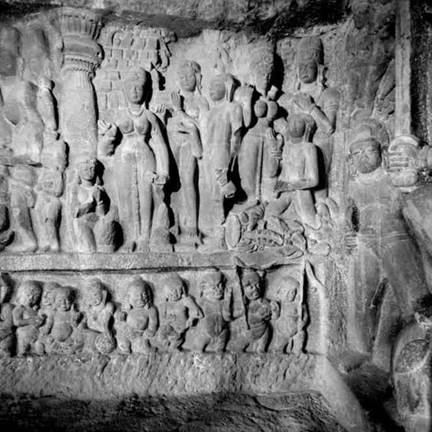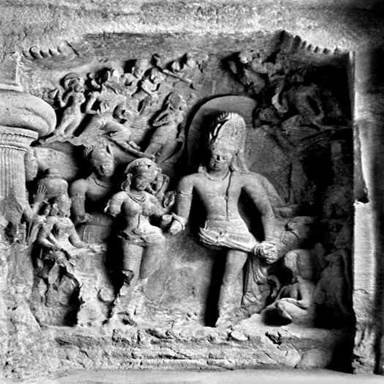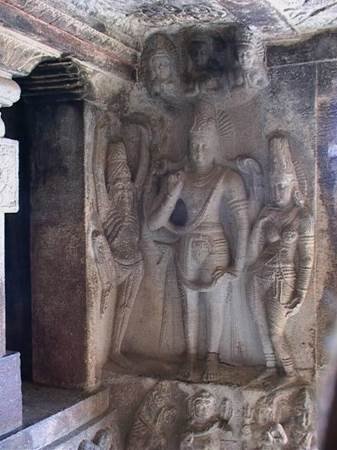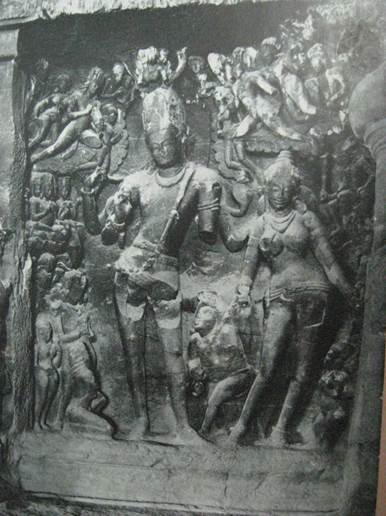Lakulisha-Pashupata (Philosophy and Practice)
by Geetika Kaw Kher | 2012 | 86,751 words
This study discusses the dynamics between the philosophy and practice in the Lakulisha-Pashupata order. According to the cave temples of Elephanta and Jogesvari (Jogeshwari), Lakulisa was the 28th incarnation of Shiva, and Pashupata Shaivism his doctrine, of which the Pasupatasutra represents the prominent text detailing various ritual practices (v...
Iconographical Explanation
Interestingly marriage of Siva and Parvati, Kalyanasundaramurti is seen in almost all the cave sites dedicated to Lakulisa Pasupatas and also it seems to have been popular theme in Orissan art, but the elaboration it has received in cave 21, Ramesvara, at Ellora is matchless. Almost an entire wall is dedicated to depicting the scence and unlike other places it is not only the marriage scene that is depicted but the entire narrative is sculpted in stone. Interestingly Parvati on right hand side is seen in an ascetic form surrounded by five fires (pancagnisadhana) practiced by the LakulisaPasupata aspirants.
 [Illustration 33. Kalyanasundaramurti, Cave 21,Ellora, Kalacuri, 6th CE] |
 [Illustration 34. Kalyanasundaramurti, Cave 1,Elephanta, Kalacuri, 6th CE] |
The theme receives a great grandeur at Elephanta but the ascetic aspect of both Siva and Parvati are not depicted here and they appear more like a royal couple. It is in this form that they are remembered and worshipped by Brahmins of Kashmir on Sivaratri, as sovereign rulers of the entire creation.
The purpose of marriage was the birth of Skanda, would be slayer of Tarakasur. What comes as a surprise is the fact that the gods feared the force of Siva and Parvati‘s power together and decided to rob Parvati of Siva‘s seed. Now Skanda Purana does allude to Agni taking up a part of overflowing seed and depositing it in Ganges and getting cursed in return by Parvati.
Thus, Agni, who was suffering from extreme heat that generated in his body, sat at a lonely place waiting eagerly for a woman to arrive there.He did not have to wait for too long, as six Kritikas, shivering with cold arrived there to warm themselves. The seeds of Siva entered into their bodies through the pores.
When their respective husbands leartnt about their pregnancy they cursed them. As a result they got transformed into ' Naksharas' and established themselves in the sky. But, they aborted their respective foetus at Himalaya mountain before getting transformed into six constellations. The holy Ganges carried that foetus to a secluded place, which was covered with dense bushes of reeds.In course of time, Lord Kartikeya manifested from those reed bushes. He had six heads. The deities were delighted at the birth of Kartikeya. Lord Siva along with Parvati went to the place where Kartikeya had incarnated. Parvati took young Kartikeya in her embrace.
This unnatural and fascinating birth story of Skanda/Kumara probably again talks about the shifting status of Siva from an ascetic to an householder, yet maintaining his stature as a great yogi.
Another form of Siva and Parvati seen in this context of union is the Ardhnarisvara form. Collins[1] observes
“Siva as half male and half female is a dynamic personification of a dualist principle that is specifically related to the Pasupatas in the Linga Purana”
This form of Siva is mentioned briefly in the Mahabharata several times: in Book XIII, Chapter 14, Upamanyu praising Siva, says ―Who else is there that has half his body occupied by his dear spouse‖
Ardhanarishvara is depicted as half male and half female, split down the middle. The right half is usually the male Shiva, illustrating his traditional attributes.
Ardhanarishvara represents the synthesis of masculine and feminine energies of the universe (Purusha and Prakriti) and illustrates how Sakti, the female principle of God, is inseparable from (or the same as, according to some interpretations) Siva, the male principle of God. The union of these principles is exalted as the root of all creation.
The conception of Ardhanarishvara may have been inspired by Vedic literature's composite figure of Yama-Yami later adopted as Yab-Yum figures in Vajrayana Buddhism. The Brihadaranyaka Upanishad says that Purusha splits himself into two parts, male and female, and the two halves copulate, producing all life–a theme concurrent in Ardhanarishvara's tales.
The Svetasvatara Upanishad sows the seed of the Puranic Ardhanarishvara. It declares Rudra–the antecedent of the Puranic Siva–the maker of all is the root of Purusha (the male principle) and Prakriti (the female principle), adhering to Samkhya philosophy. It hints at his androgynous nature, describing him both as male and female.
In a story from Skanda Purana, Parvati requests Siva to allow her to reside with him, embracing "limb-to-limb", and so Ardhanarishvara is formed.
In other Puranas like the Linga Purana, Vayu Purana, Vishnu Purana, Kurma Purana, and Markandeya Purana, Rudra (identified with Siva) appears as Ardhanarishvara, emerging from Brahma's head, forehead, mouth or soul as the embodiment of Brahma's fury and frustration due to the slow pace of creation. Brahma asks Rudra to divide himself, and the latter complies by dividing into male and female. Numerous beings, including the 11 Rudras and various female shaktis, are created from both the halves. In some versions, the goddess unites with Siva again and promises to be born as Sati on earth to be Siva's wife[2] .
Tamil temple lore narrates that once the gods and sages had gathered at Shiva's abode, they prayed their respects to Shiva and Parvati. However, the sage Bhringi had vowed to worship only one deity, Siva, and ignored Parvati while worshipping and circumambulating him. Agitated, Parvati cursed Bhringi to lose all his flesh and blood, reducing him to a skeleton. In this form Bhringi could not stand erect, so the compassionate ones who witnessed the scene blessed the sage with a third leg for support. As her attempt to humiliate the sage had failed, Parvati punished herself with austerities that pleased Shiva and led him to grant her the boon of uniting with him, thereby compelling Bhringi to worship her as well as himself in the form of Ardhanarishvara. However, the sage assumed the form of a beetle and circumambulating only the male half, drilling a hole in the deity. Amazed by his devotion, Parvati reconciled with the sage and blessed him. An interesting visual depiction of this myth can be seen from Aihole and curiously it is clubbed with Gangadhar aspect of Siva too.

[Illustration 34. Gandhadhar Siva with Parvati and Bringhi, Ravan Phadi, Aihole, Karnataka,6th CE]
Kalika Purana states that, Parvati (called Gauri here) is described as having suspected Siva of infidelity when she saw her own reflection in the crystal-like breast of Siva. A conjugal dispute erupted but was quickly resolved, after which Parvati wished to stay eternally with Siva in his body. The divine couple was thereafter fused as Ardhanarishvara. Another tale from North India also talks about Parvati's jealousy. Another woman, the river Ganga–often depicted flowing out of Shiva's locks–sat on his head, while Parvati (as Gauri) sat on his lap. To pacify Gauri, Siva united with her as Ardhanarishvara. Thus the presence of both myths together in one panel is justified by such connections drawn in Puranic and regional legends.
Another panel indirectly hinting at the discomfort that Parvati felt after Siva held Ganga in his locks is the one seen at Elephanta where the artist cleverly has used the space between Siva and Parvati to suggest uneasy silence between the divine couple.

[Illustration 35. Gangadhar Siva with Parvati, Cave 1, Elephanta, Kalacuri, 6th CE]
It is in Ramayana that we find Siva agrees to hold Ganga in his locks to control her torrential flow. On one hand we see Ganga as the carrier of Siva’s seed and on the other as a prisoner in his locks, both suggesting an intimate link between both.
Mythopoeic imagination reads this relation as that of a consort and she is often shown as a female figure emerging out of Siva’s jata. This aspect comes across clearly in Kalidasa’s Meghaduta[3] :
“From there you should go to Jahnu‘s daughter who descends
From the Lord of the peaks near Mount Kanakhala
And once served Sagara‘s sons as a stairway to heaven
It was she,Ganga, her foam like laughter‖
An elaborate description of this theme can be seen in a panel in Mahabalipuram which depicts the harsh penance of Bhagiratha to please Siva.
![]()
[Illustration 36.Gangavtarana Panel, Mahabalipuram,Tamil Nadu, Pallava, 7th CE]
Another interesting myth one encounters in Skanda Purana is the myth of Kaalbhiti who did not leave the womb of his mother for four years as he feared Kala. After being reassured and granted a boon he grew up to be a virtuous person. He used to engage himself in various kinds of austerities and was a great devotee of Lord Siva. One day, as Kaalbhiti was meditating under a 'bael' tree (wood apple), he went into trance. The joy experienced during trance period was something, which he had never experienced before. He decided to regularly meditate under that tree. He did penance for one hundred years standing on his toe pleasing Siva who appeared in form of a linga and freed him from fear of death. Since he had conquered death he was known as Mahakaal. This myth connects strongly with the Mahakaal temple at Ujjain and it evidently has some Kapalika or Siddha connection as aspirants of both cults desired to conquer death and gain perpetual immortality through harsh yogic practices.The importance given to pancbrahmamantras in this tradition point at him being a Pasupata saint.
Footnotes and references:
[1]:
Collins,Charles D. The Iconography and Ritual of Siva at Elephanta.Delhi: Sri Satguru Publications,1991 p.81
[2]:
Kramrisch Stella, ‘(1981). The Presence of Siva. Princeton University Press.. pg 200-208)
[3]:
Meghaduta as quoted by Collins p.75
